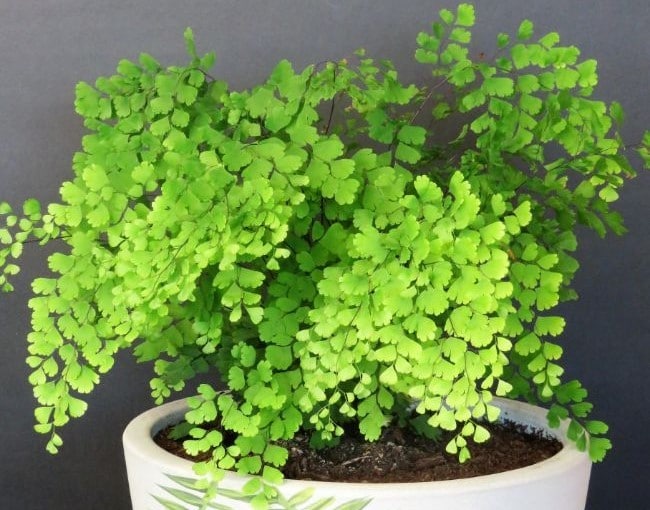For plant lovers who want a touch of tropical beauty in their homes, but don’t want the hassle of dealing with stringent heat and lighting requirements, the Maidenhair fern is a fantastic option to consider. Lets’s start with a summary of maidenhair fern care, before moving onto the detail.
How to care for a Maidenhair fern: Maidenhair ferns needs partial to full shade, high humidity, continually moist soil and temperatures of 60-80°F (16-27°C) to thrive. Provide fertile, well-drained soil with lots of organic matter and fertilize monthly with a balanced, liquid or water soluble fertilizer during the growing season.
If you are looking to incorporate beautiful, year round greenery into your home, read on for a complete rundown on how to care for this gorgeous fern. This guide covers how to provide the best conditions for your Adiantum, as well as how to deal with common problems with maidenhair fern care.
Summary Of Maidenhair Fern Care
- Scientific Name: Adiantum
- Common Name: Maidenhair Fern, Walking Fern
- Light Requirements: Indirect light. Will tolerate lower light conditions well.
- Watering: Maintain continually moist soil, but avoid waterlogged conditions.
- Soil: Fertile, well-draining potting mix. Equal parts potting mix, peat and compost works well.
- Temperature: 60-80°F (16-27°C).
- Fertilizer: Balanced, water-soluble fertilizer applied monthly through the growing season.
- Humidity: High humidity is important. Aim for at least 50% humidity.
- Pruning: Remove old, dead fronds, but otherwise minimal pruning required.
- Propagation: Easy to propagate by division of the rhizome.
- Re-Potting: Only needs repotted once every few years.
- Diseases and Pests: Quite resistant to pests and disease.
- Toxicity: Non-toxic.
- Where To Buy: Buy a Maidenhair Fern online at Etsy (I buy most of my houseplants from Etsy).
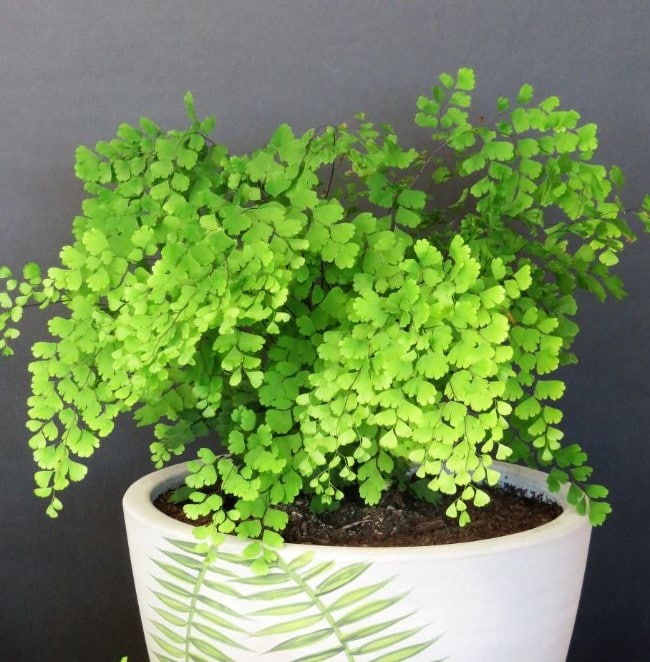
Overview of the Maidenhair Fern
The Maidenhair fern has a unique lacy appearance, compact growth habit and small fronds that produce a beautiful display of greenery. Unlike some of their tropical cousins, Maidenhair ferns thrive in cold climates, even surviving the cold winters in Zion National Park which is located at 3,000 feet in the Utah Mountains.
The Maidenhair fern is also known as the “walking fern” and by its scientific name of “Adiantum.” While there are about 250 species of this type of fern in the genus, only a few of these species are grown ornamentally.
The common name of “maidenhair” stems from the fact that the fern has the ability to produce a type of oil that can be used in making shampoo.
Adiantum species grow around the world, from Asia, to the Andes Mountains of South America, to the California coast. Like many types of ferns, they thrive in areas where constant moistness is present.
While the Maidenhair fern prefers rich, deep humus soil, they have also been known to thrive in areas of poor soil, even growing on vertical rock faces underneath waterfalls. Thus, while well-draining soil is important for this plant, a constant source of moisture is much more important.
One of the reasons that the Maidenhair fern is one of the most widely cultivated ornamental ferns in North America is due to the enchanting fragrance that the fronds can give out.
While this scent is less perceptible than some common household flowers, it does add a unique essence to any room, balcony, or patio. Lastly, the contrast in color between the dark stems and the evergreen leaves is also appreciated by plant lovers.
Maidenhair Fern Characteristics
Knowing the essential characteristics of the Maidenhair fern is important in order to create the right environment for optimum growing conditions. As with any plant, your goal should be to create a growing environment and conditions that resemble, as closely as possible, the natural habitat of the plant.
- Family: Pteridaceae
- Genus: Adiantum
- Species: Over 250 known, though the most commonly grown for ornamental purposes include the Adiantum capillus-veneris, Adiantum pedatum (five-fingered fern), and the Adiantum jordanii (California Maidenhair), which is native to the west coast of the United States.
- Native Habitat: The Maidenhair fern thrives in different areas around the world, but is mostly found in tropical, sub-tropical, and temperate areas where constant, year round moisture is present.
- Growth Characteristics: It usually grows to a modest height of anywhere between 8-14 inches, (20-35 centimeters), though some varieties can grow up to 40 inches in height.
- Coloration: This evergreen plant has brown, black, or occasionally dark purple petioles (stems) with light to dark colored green foliage.
- Growth Characteristics: The majority of ferns from the Adiantum genus grow as hanging ferns, though some also display upright growth habits.
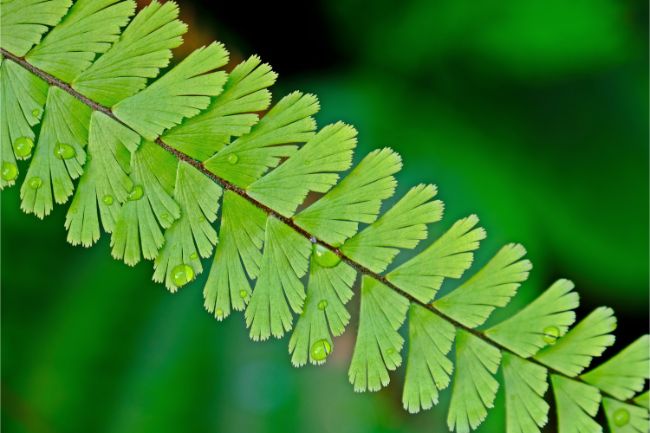
Maidenhair Fern Light Requirements
Maidenhair ferns do best in bright indirect light, and are unable to tolerate much direct sunlight. They will also tolerate low light conditions, although they will not grow as well as in better light.
Maidenhair ferns are most often found in nature around springs, waterfalls, rivers, and streams where the constant moisture is accompanied by shady conditions. In fact, these types of plants can even be found growing under rock ledges where any sunlight is a rare occurrence.
Whether you are planning to grow the maidenhair fern indoors or outdoors, it needs to be protected from the midday sun. This will quickly cause the leaves to turn brown, and could kill the plant after extended exposure.
If you live in the northern hemisphere, an east or north facing windowsill will usually provide perfect light conditions.
Watering Maidenhair Ferns
Maidenhair ferns require regular watering to make sure the soil remains evenly moist and never dries out.
My preferred way of watering my maidenhair fern is to take it to the sink and gently water the top of the soil until water starts running freely out of the drainage holes.
I then leave it in the sink for a few minutes to let any excess water drain out of the drainage holes, before placing it back onto it’s drip tray. This is really important, as while Maidenhair ferns love wet soil, it they are sitting in a puddle of water in their drip tray, the soggy soil can easily cause root rot.
Placing your maidenhair fern anywhere near a heating or cooling vent can quickly cause the plant to dry out. While soft breezes from an open window shouldn’t cause too much problems, sources of dry heat will cause it dry out and die.
Maintaining evenly moist soil conditions can be tricky, so you will need to keep a close eye on the condition of your maidenhair fern and the soil. I’ve written an article about how to assess when to water houseplants which is an essential skill to master to keep your houseplants thriving.
Maidenhair ferns, and many other common fern houseplants make good candidates to grow in self-watering pots, as these tend to maintain evenly moist soil. Read this article to learn how self-watering pots work and here’s an article about my favorite choices for self-watering pots.
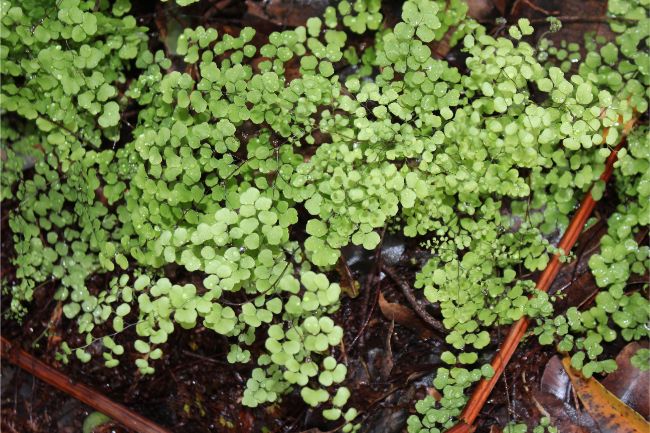
Humidity Requirements For The Maidenhair Fern
Maidenhair ferns grow best in an environment with constantly high humidity, and if grown indoors, should be placed a safe distance from heating or cooling vents.
While a humid home can lead to mold and mildew problems, you can easily create a humid microclimate in a number of easy ways, which I cover in this article. Consider using the following to increase humidity;
- Use a humidity tray
- Group your houseplants together
- Place your Maidenhair fern in a bathroom
- Use an electric humidifier
Soil Conditions For The Maidenhair Fern
Maidenhair ferns are unique in that they have the ability to grow in extremely poor and fragile soils, as long as there is a constant source of shade and moisture. In some cases in the natural world, Maidenhair ferns can even grow on rock walls or ledges where their thin roots find their way into crevices to attach to the wall.
This doesn’t mean, however, that you should neglect the choice of soil for your fern. In general, Maidenhair ferns prefer fertile, well-drained soil with a high amount of organic matter.
If you are planting your Maidenhair fern in a pot, you should definitely find a pot that has drainage holes in the bottom. Despite the fact that these ferns love constantly moist growing conditions, waterlogged soils can damage the root structure, stress the plant, and eventually kill it off.
While you could simply purchase a potting soil mix at your local home gardening store, it’s very easy to make your own soil mixture that your maidenhair fern will thrive in.
A good, homemade potting mix for your Maidenhair fern is one part potting mix, one part compost, and one part peat. This will ensure that you have a fertile, nutrient dense, well-draining soil for your fern to thrive.
The potting mix offers the base nutrients and growing conditions, the compost offers extra nutrients and moisture retention, while the peat adds a lightweight dimension to help improve drainage and prevent waterlogging.
In terms of soil pH, this type of fern will do better in a slightly alkaline soil, and a bit of ground limestone can be useful in helping to make sure that the roots of the plants can absorb nutrients.
Maidenhair Fern Temperature Requirements
Maidenhair ferns prefer constant temperatures of 60-80°F (16-27°C). Most homes will easily maintain this, though you will want to take care not to place the fern near a south or west facing window where the hot summer sun could create a hotter microclimate.
If you are planning on planting your Maidenhair fern outside, most of these species will tolerate colder conditions than other types of ferns. Temperatures down to 50°F (10°C) shouldn’t cause much harm and some varieties are even somewhat frost resistant.
In many cases, if you forget to bring your fern inside and it suffers a hard frost, the leaves might brown as a sign of going dormant. However, the underground bulb will stay alive and continue to send out new shoots as soon as it is placed indoors again.
In areas with long, cold winters, simply take your Maidenhair fern inside during the winter months and try to avoid exposing it to prolonged frosts that could lead it into dormancy.
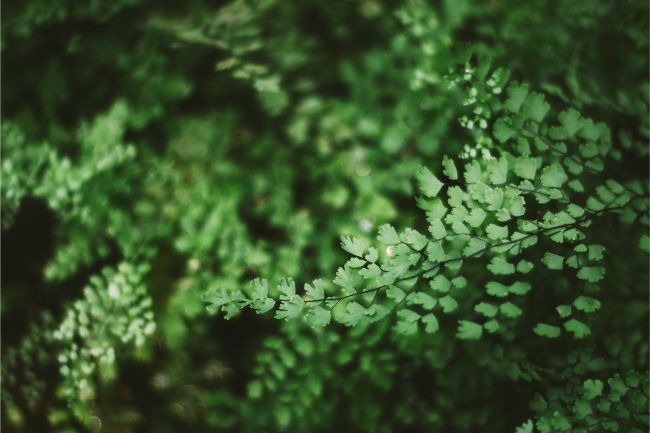
Fertilizer For Maidenhair Fern
Like all house plants, the Maidenhair fern requires fertilizer to help it continue to grow. You should only fertilize the Maidenhair fern in the spring, summer, and early fall when the plant is actively growing.
I recommend using a balanced, liquid or water soluble fertilizer monthly while the plant is actively growing. Prepare the fertilizer at half the recommended strength on the pack, as this reduces the risk of nutrient toxicity.
Another option is to top dress the soil around the base of your Maidenhair fern with slow release fertilizer granules that you can purchase at your local garden supply store. If, however, your potting mix is labeled as a slow release fertilizer, you probably shouldn’t add any other additional nutrients.
Pruning Considerations For Maidenhair Ferns
Maidenhair ferns have few pruning requirements. This plant will naturally get rid of the older fronds to make room for new growth. The only task for you is to gently remove the dried up fronds that usually appear at the base of the plant.
If your Maidenhair fern is showing signs of disease you should also use simple pruning scissors to remove any damaged or diseased fronds. Make sure to clean the blades of your pruners with rubbing alcohol to avoid spreading fungal or bacterial diseases to healthy foliage on the fern.
Propagation And Re-Potting Ideas For The Maidenhair Fern
One of the best parts of cultivating your own household plants is that you can quite easily and cheaply propagate to fill your own home with vibrant greenery. In the case of the Maidenhair fern, propagation is fairly easy and straightforward.
Whilst maidenhair ferns don’t have to be repotted more than once every few years, repotting is a good opportunity to propagate your plant. The best way to propagate a maidenhair fern is by division of the rhizome, which is best done in the spring, at the start of the growing season.
To successfully divide your Maidenhair fern and propagate new plants follow these steps:
- Carefully lift up the entire plant, taking care to not break or damage the roots.
- Place the entire plant on a clean surface or piece of newspaper
- With a sharp knife, carefully divide the rhizome into several sections as desired, making sure to keep at least two fronds attached to each root section.
- Make sure to leave enough roots so that the new plant can get started and grow vigorously.
- Never forcefully pull the shoot or root cutting away from the mother plant as this can damage the root system of both the mother and the shoot.
- Repot the offset in a separate container with the potting mix detailed above.
- Replant the now-thinned mother plant in the original container with fresh potting mix.
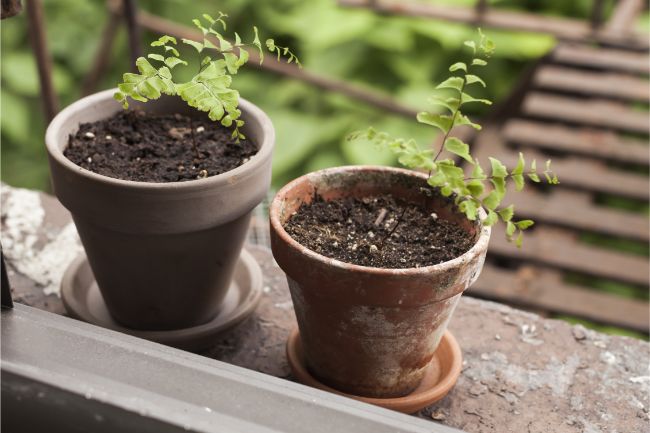
Maidenhair Fern Diseases And Pests
The vast majority of health problems that affect Maidenhair ferns will occur due to problems with lighting and watering. If you see signs of yellow or brown leaves, the first thing you should check is the soil humidity level and whether or not the fern is being exposed to excessive sunlight.
In most cases, the Maidenhair fern will not be affected by insect pests or fungal diseases. Because the fern thrives in moist conditions, it has adapted to coexist with certain fungal spores that do not affect the growth of the plant.
On occasion, scale, mealybugs, or aphids can take up residence on your Maidenhair fern. You should regularly check your plant for any evidence of bugs and deal with them promptly. If you do find bugs on your Maidenhair fern, try one of these methods to get rid of the bugs naturally.
Usually, you can control insect pests by hand removing these pests. In the case of a major invasion of the soil, you can consider repotting your plant in healthier soil. As with all household plants, creating a fertile growing environment will allow your Maidenhair fern to grow strong and resilient so that it can naturally resist pest invasions.
Common Questions
By following the growing advice above, most plant lovers will be able to successfully grow and propagate Maidenhair ferns around their home. By providing abundant moisture, humidity, and limiting sunlight, most Maidenhair fern plants will thrive. This FAQ section will help you identify and fix the most common problems with maidenhair ferns.
Why does my Maidenhair fern have brown leaves?
If the green leaves or fronds of your Maidenhair fern are turning brown, there are usually three common causes:
- Too much direct sunlight is causing your fern to dry up.
- Insufficient humidity.
- Your water may contain high levels of chlorine, fluoride or dissolved minerals.
If you notice browning leaves or fronds, move your Maidenhair fern to a different part of your home with more shade and discontinue watering with tap water. Collected rainwater, distilled or filtered water can be used. Check humidity levels and increase where needed. Also, with clean pruning snips, cut away the dead or brown fronds in order to encourage new growth.
What is causing the fronds on my Maidenhair fern to curl up?
Excessive curling at the tips of your Maidenhair fern is most likely being caused by a lack of humidity in the ambient air. This can eventually lead to the leaves or fronds completely drying up and falling off.
Move your fern away from any air vents and increase ambient humidity levels using one of these methods.
Why is my Maidenhair Fern not growing quickly?
Maidenhair ferns will grow healthily and quickly when they are given the conditions they require for growth. Slow growth is likely linked to a problem with watering, light, soil, fertilizer, or another aspect of care. Take some time to consider each aspect of care in turn and adjust the conditions as required.
If you have just repotted a Maidenhair fern via rhizome division, bear in mind that it may take several weeks or months for the roots to recover from the shock of being transplanted.
Last Word
With a little bit of work and patience, you can keep your Maidenhair fern thriving for years. I hope I’ve managed to cover all your questions in this article about maidenhair fern care. If you still have any questions, please let me know.

